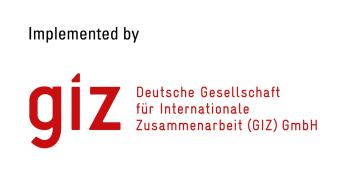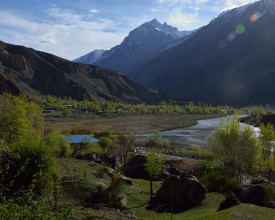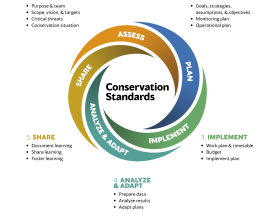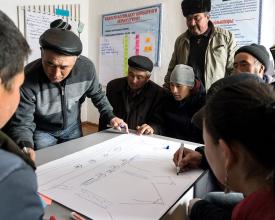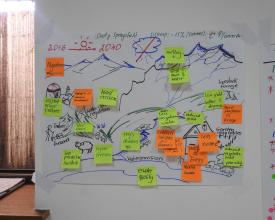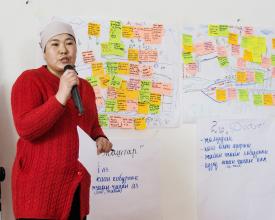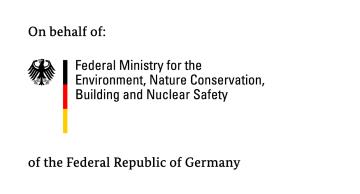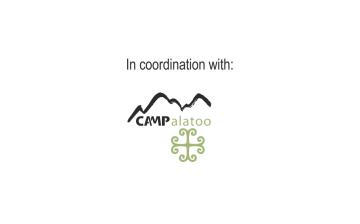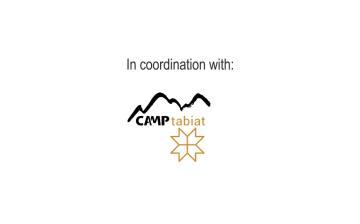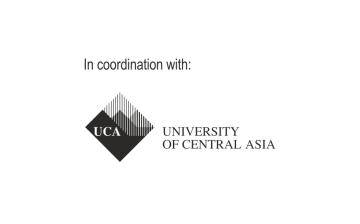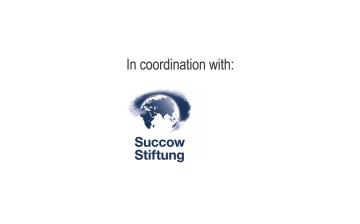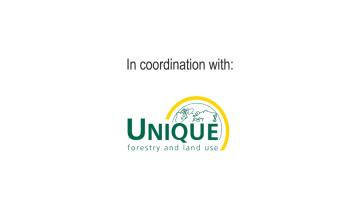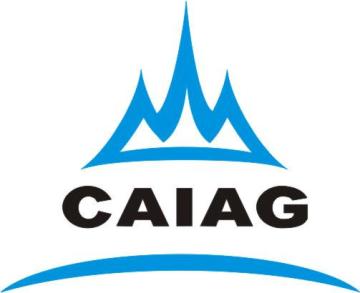
El método basado en las normas de conservación para planificar y aplicar estrategias de adaptación basadas en los ecosistemas
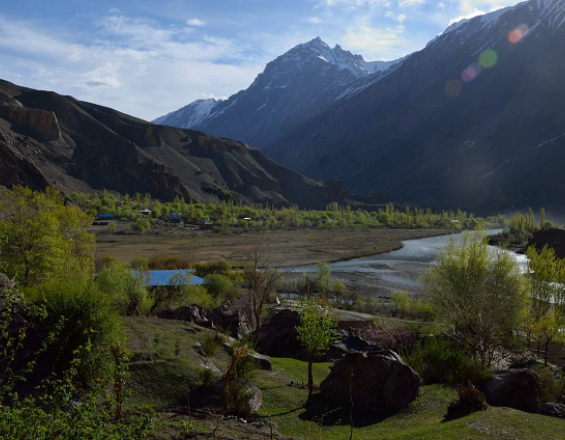
Las Normas de Conservación Aplicadas a la AbE son fruto de la colaboración entre el equipo del proyecto de Asia Central dirigido por la Deutsche Gesellschaft für Internationale Zusammenarbeit (GIZ) GmbH que trabaja en AbE y el Grupo de Trabajo de Orientación Climática de la Asociación para las Medidas de Conservación (CMP). El método se basa en los ya ampliamente utilizados Estándares Abiertos para la Práctica de la Conservación (Estándares de Conservación) de la Alianza para las Medidas de Conservación para proponer una forma de diseñar, implementar y aprender de las intervenciones de AbE. CMP y GIZ han trabajado juntos para desarrollar este método basado en un proyecto EbA en Asia Central, pero dirigido a una audiencia global de profesionales EbA y las comunidades con las que trabajan.
Contexto
Défis à relever
El enfoque político de la gestión de los recursos naturales en Asia Central sigue siendo descendente, lo que no permite ofrecer soluciones localizadas y adaptadas a los efectos negativos del cambio climático. Las estructuras de gobierno locales no están dotadas de suficientes recursos financieros y a menudo carecen de capacidades para crear planes de gestión integrales que incorporen información climática. Los diversos ecosistemas de las altas regiones montañosas de Asia Central proporcionan bienes y servicios esenciales, como agua potable, productos forestales y protección contra las catástrofes naturales. Sin embargo, las prácticas inadecuadas de gestión de la tierra, unidas a los efectos del cambio climático, suponen una grave amenaza para los ecosistemas sensibles y ya han provocado una creciente degradación. El método EbA aquí esbozado ayuda a superar estos problemas con un enfoque integrado que también tiene en cuenta el Desarrollo de Capacidades. La información sobre el clima y las soluciones basadas en la naturaleza ayudan a las personas a adaptarse al cambio climático.
Ubicación
Procesar
Resumen del proceso
Los Building Blocks presentados son pasos dentro del Método EbA desarrollado. BB 1 representa los Pasos 2-4, mientras que BB 2 se centra en el Paso 5. A través de la aplicación de los, en total, 13 Pasos, usted desarrolla una comprensión de cómo los medios de subsistencia y el bienestar de la comunidad dependen de los servicios de los ecosistemas. Con este conocimiento, se documentan los impactos observados y probables del cambio climático en los ecosistemas que proporcionan esos servicios esenciales. A continuación, se examinan las relaciones entre el cambio climático y otras amenazas convencionales, se identifican los factores socioeconómicos que contribuyen a las amenazas y se definen las intervenciones de adaptación. A continuación, define cómo cree que estas intervenciones abordarán toda la gama de amenazas climáticas y no climáticas y contribuirán a conservar o restaurar los ecosistemas de los que dependen las personas (su "teoría del cambio"). Además, puede utilizar el método CoSEbA para determinar cómo supervisar y evaluar los avances hacia sus metas y objetivos, a fin de garantizar una gestión adaptativa y un aprendizaje continuo. Mediante la adopción de intervenciones de AbE, puede mejorar las prácticas de uso de los recursos naturales de las comunidades y mejorar la salud de los ecosistemas y la prestación de servicios ecosistémicos, reduciendo al mismo tiempo la vulnerabilidad climática.
Bloques de construcción
Evaluaciones participativas de la vulnerabilidad como base para la planificación de la AbE
Esta fase del proceso tiene por objeto evaluar la información sobre las vulnerabilidades convencionales (no climáticas) de las personas y los ecosistemas. Las encuestas realizadas en cuatro pueblos de la provincia kirguisa de Naryn y del valle tayiko de West-Pamiri Bartang abordaron las siguientes cuestiones:
- Servicios ecosistémicos utilizados por la población local y su distribución espacial y temporal.
- Disponibilidad de servicios ecosistémicos, salud y función de los ecosistemas y cambios percibidos
- Vulnerabilidad de los medios de subsistencia y su relación con el estado y la disponibilidad de los servicios ecosistémicos
- Percepción del cambio climático y sus efectos sobre la disponibilidad de los servicios ecosistémicos
- Evaluación de los déficits legales, institucionales, administrativos, técnicos y de información relevantes para la AbE en la zona.
El trabajo de campo comenzó con talleres en las aldeas para presentar el proyecto e identificar a los principales interesados, así como los intereses y las necesidades de los habitantes de las aldeas. La información se recopiló mediante entrevistas con residentes e informantes clave, debates en grupo, estudios de campo (paseos por el pueblo, cartografía, muestreo) y cartografía participativa de recursos. Para evaluar la vulnerabilidad global, se clasificó comparativamente la disponibilidad de servicios ecosistémicos y su contribución a los medios de vida locales.
Factores facilitadores
- Determinación detallada del alcance (Paso 1) antes de la evaluación: elección de la comunidad, (pre)identificación de las estrategias de subsistencia, los servicios ecosistémicos y los ecosistemas respectivos.
- Enfoque participativo en el que intervengan los habitantes de las aldeas e informantes clave
- Realización de talleres en las aldeas en un lenguaje sencillo (más allá de la terminología del proyecto)
Lección aprendida
- Debe evitarse una evaluación de vulnerabilidad independiente realizada por expertos externos. La mayor parte de la información necesaria para la planificación posterior no puede obtenerse únicamente de los informes.
- El método EbA desarrollado comprende una evaluación completa de la vulnerabilidad: Etapas 1-4 (determinación del alcance e identificación de las amenazas convencionales), 5 (perspectiva climática), 6 (priorización de las amenazas) y 7 (resumen de la situación).
- Identificar las vulnerabilidades de las personas es bastante sencillo. Sin embargo, identificar las vulnerabilidades de los ecosistemas pertinentes y asegurarse de que la propia naturaleza es capaz de adaptarse plantea un reto debido a la falta de datos y a las limitaciones de tiempo.
- Las disparidades sociales convierten la vulnerabilidad climática en una vulnerabilidad de los medios de subsistencia impulsada socialmente. Un acceso desigual al agua aumentará la vulnerabilidad social de los medios de subsistencia. Una estrategia EbA tendrá que abordar un acceso socialmente compensatorio al recurso.
- Alcance: es importante ampliar la zona del proyecto para abarcar el ciclo vital completo (por ejemplo, los pastos de verano) de la población destinataria.
Integrar la información climática en la planificación local
Se elaboraron proyecciones estacionales (basadas en las estaciones definidas por las comunidades en función de las estrategias de subsistencia predominantes con ayuda de un calendario ecológico) y anuales de temperatura y precipitaciones para un futuro próximo en lugares concretos, a saber, el distrito de Bash Kaiyndy/Naryn, en Kirguistán, y dos pueblos del valle de Bartang, en la región tayika del Pamir. Se elaboraron dos cortes temporales para representar medias de 30 años -década de 2020 (2011-2040) y década de 2050 (2041-2070)- y se calcularon los factores de cambio en relación con los periodos base modelizados de 1980-2005. La presentación de las proyecciones en forma de intervalo representa con mayor precisión las posibles condiciones climáticas futuras para los responsables de la toma de decisiones y los planificadores que aplican un enfoque basado en el riesgo a la adaptación al cambio climático y la resiliencia. Para tener en cuenta las incertidumbres inherentes a los modelos climáticos, los escenarios de vulnerabilidad futura se debaten y seleccionan junto con la comunidad. A partir de los escenarios, las amenazas relacionadas con el cambio climático completan el panorama del análisis de la situación, y las vulnerabilidades futuras pueden priorizarse mediante la clasificación de las amenazas convencionales y las relacionadas con el cambio climático.
Factores facilitadores
- Las aldeas de Kirguistán disponen de datos de estaciones meteorológicas para respaldar la información de referencia. Podrían estimarse los valores absolutos futuros.
- Ejercicio de calendario ecológico realizado con las comunidades locales para definir la distribución de las estaciones en función de las estrategias de subsistencia predominantes.
- Fuerte intercambio entre los científicos del clima y los socios ejecutores locales y la comunidad
- Gran capacidad de facilitación a la hora de comunicar los escenarios futuros a la comunidad
Lección aprendida
- Construir el puente entre la ciencia y el desarrollo local integrando la percepción local en la modelización de proyecciones y mediante la planificación participativa de escenarios con la comunidad ha dado muy buenos resultados.
- Al introducir la idea del cambio climático en los talleres, puede existir el peligro de presentar el cambio climático como la causa de todos los problemas medioambientales. Es esencial explicar y definir cuidadosamente el cambio climático.
- Es crucial adaptar las proyecciones climáticas a la audiencia específica (por ejemplo, funcionarios del gobierno, aldeanos locales).
- Los talleres y debates previos con diversos informadores familiarizados con la zona del proyecto y con los habitantes de las aldeas aportaron información útil y una visión más completa del contexto ecológico y económico de la evaluación.
- Los talleres no suelen ser un foro productivo para debates técnicos sobre la validez de las proyecciones climáticas y las estadísticas. Resulta útil centrarse en la comunicación de los impactos y peligros climáticos, más que en los tecnicismos.
Impactos
Junto con las comunidades locales, se han puesto en marcha procesos innovadores de planificación de la adaptación al cambio climático. La aplicación participativa del método aclaró a las partes interesadas locales las posibles amenazas convencionales y relacionadas con el cambio climático, así como las capacidades de adaptación de las comunidades y los ecosistemas locales a las tendencias actuales y a largo plazo del cambio climático. Permitió identificar las opciones de adaptación más prometedoras y resistentes a diferentes escenarios climáticos, centrándose principalmente en la mejora de la gestión de los pastos y los bosques, así como en medidas de conservación del agua. Además, se han presentado a los hogares oportunidades alternativas de ingresos, como el turismo y la transformación de la fruta. El nivel de conocimientos de las autoridades locales, los especialistas de las instituciones del sector público y la población local sobre los problemas del cambio climático y la necesidad de adaptarse con soluciones basadas en la naturaleza ha mejorado gracias a la comunicación y la educación medioambiental. Se ha reforzado la capacidad de las instituciones de las aldeas para planificar con flexibilidad la gestión de los recursos naturales y tomar decisiones sobre la conservación y restauración de la biodiversidad. Las autoridades locales y las instituciones de los pueblos están ahora familiarizadas con las características de la toma de decisiones en un clima cambiante (planificación de escenarios). Estas medidas conjuntas permitirán a los habitantes de las regiones de alta montaña adaptarse mejor al cambio climático.
Beneficiarios
Los principales beneficiarios son las comunidades de las cuencas piloto. El método EbA también se consagrará en los documentos de planificación estratégica a escala nacional y regional y en la planificación de los principales socios internacionales.
Objetivos de Desarrollo Sostenible
Historia
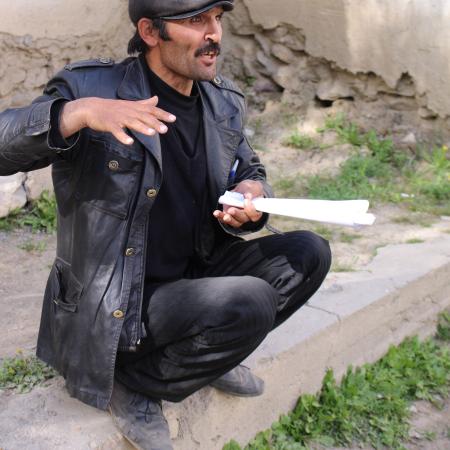
Navruzmamad Bodurov tiene 46 años, y casi toda su vida ha vivido en la aldea de Siponj del valle de Bartang,Tayikistán. "Llevo 20 años trabajando como profesor en nuestra escuela rural. También empecé a dedicarme a la apicultura, que aporta ciertos ingresos a nuestra familia. También trabajo como voluntaria en nuestra organización rural. Hago este trabajo para contribuir al desarrollo de nuestra comunidad. Me gustaría dar a la gente esperanzas de un futuro mejor y mostrarles un ejemplo de éxito. Nuestro pueblo es rico en agua, tierra y pastos. Estos recursos son muy importantes para nosotros. Las principales fuentes de ingresos de la población local, además de las remesas de nuestros emigrantes laborales, son la agricultura y la ganadería. Para mejorar la vida de nuestros conciudadanos, es necesario desarrollar un sistema agrícola y ganadero más eficaz, en el que participen especialistas en esos campos. Deseo de verdad que nuestros hijos tengan una vida mejor que la nuestra".
Conectar con los colaboradores
Otros colaboradores
Otras organizaciones
